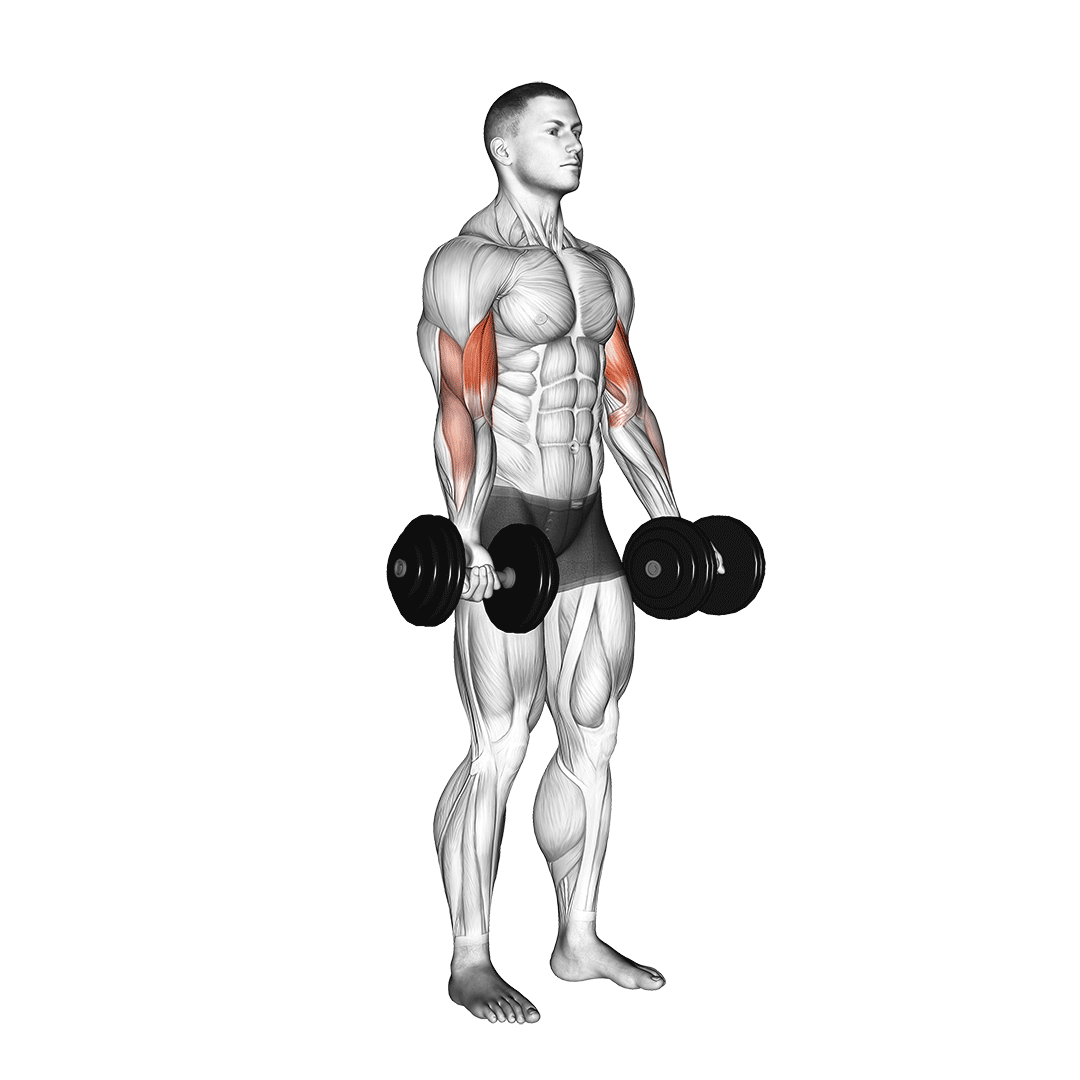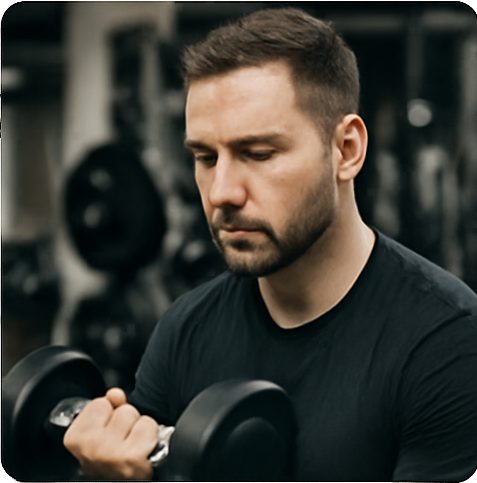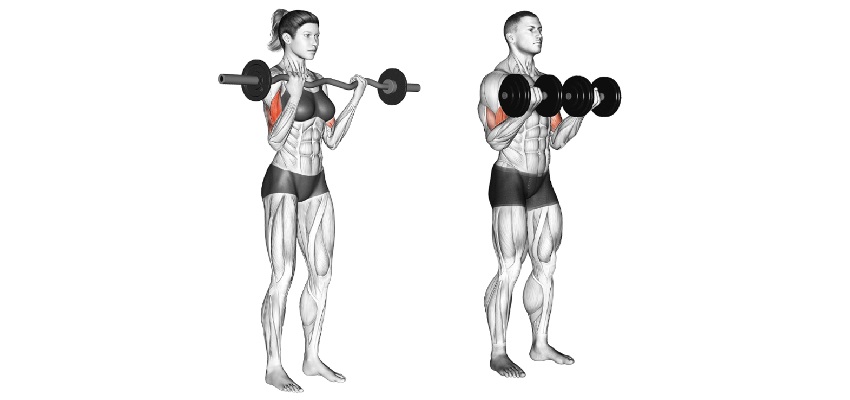Barbell curl vs dumbbell curl — I didn’t think there’d be much difference. I mean, it’s still curling weight, right?
At first, I was killing it with dumbbells. I could curl 20kg in each hand for a clean 8 reps. No problem. Felt solid. Then I figured I’d switch things up and try barbell curls. I thought, “Cool, 20 + 20 = 40kg, let’s go.”
Yeah… nope.
The barbell felt way heavier. Like, way heavier. I could barely hit 5 clean reps. Same weight, but it hit different. At first, I thought I was just having an off day. But the more I trained, the more I realized — these two movements aren’t the same at all.
That’s what got me curious. What’s really going on with barbell curl vs dumbbell curl? This post is basically everything I learned after making the switch — the surprises, the gains, and the stuff no one told me.
Barbell Curl vs Dumbbell Curl: Difference
Barbell and dumbbell curls both effectively work the biceps, but have distinct advantages and disadvantages. Barbell curls lock both arms into a fixed path for heavier lifts, while dumbbell curls let each arm move freely for better isolation and wrist comfort.
With dumbbells, you’ve got full control. Each arm moves on its own, and you can rotate your wrists naturally. That freedom helps with form and bicep isolation. I started with dumbbells and loved how smooth they felt. Easy on the wrists too.
Then there’s the barbell. I started with a straight bar, which felt… stiff. Both arms move together, so you’re kind of locked in. The bar doesn’t let your wrists turn much. Later, I tried an EZ-bar and it was a game-changer — way more comfortable on my wrists and elbows.
Now, when it comes to barbell curl vs dumbbell curl, the big surprise was how different they feel — even at the same weight.
With dumbbells, I could control the rep and focus on the squeeze. With the barbell? It felt heavier right away. Like, even though the math said 40kg, the bar made it feel more like 45. I wasn’t expecting that.
Here’s how I see it now:
- Barbell curls let you load more weight and chase strength. Great if you’re trying to build size fast. But they’re tougher on the joints and don’t give you much freedom.
- Dumbbell curls are more flexible. You can tweak the angle, rotate your wrists, and keep things more balanced. You won’t lift as heavy, but the mind-muscle connection is better — at least for me.
Both hit your biceps hard — just in different ways. And yeah, they look the same on paper, but the feeling in the gym? Totally different.
Barbell Curl vs Dumbbell Curl: Pros and Cons
Barbell Curls: Pros and Cons
When I first jumped into barbell curls, I thought I was about to level up my biceps fast. Turns out, there’s more to it than just slapping plates on a bar. Here’s what stood out for me:
Pros
- More stability – Both hands move together, which made the lift feel more controlled.
- Easier to go heavy – Perfect for progressive overload. I could move more total weight.
- Felt strong – Honestly, nothing beats that feeling of curling a loaded bar in front of the mirror.
Cons
- Less freedom of movement – My arms were locked into one path. Felt stiff sometimes.
- Wrist pain – The straight bar especially started to wreck my wrists after a few weeks.
- Hard to spot imbalances – One arm might be doing more work, but with both hands on the bar, I couldn’t tell.
So yeah, barbell curls definitely helped with strength. But they weren’t the most joint-friendly for me over time.
Dumbbell Curls: Pros and Cons
After grinding out barbell curls for a while, I decided to bring dumbbells back into the mix — and I instantly remembered why I liked them.
Pros
- Way more natural movement – I could twist my wrists and adjust grip mid-rep.
- Better mind-muscle connection – I actually felt my biceps working more.
- Wrist-friendly – Way less strain compared to the barbell.
Cons
- Progress is harder to track – No single bar to load. You’ve gotta stay on top of rep quality.
- More stabilizer effort – Each arm’s doing its own thing. Takes more focus and control.
- Can’t lift as heavy – Ego took a hit. But the pump was still real.
So, when it comes to barbell curl vs dumbbell curl, here’s my take: use both. Barbell curls for strength. Dumbbells for balance, control, and long-term gains without wrecking your wrists.
Barbell Curl vs Dumbbell Curl: How I Train Smarter Now
Barbell Curl Form Cues

- Grip width matters: I used to grip the bar too wide or too narrow. Now I go slightly wider than shoulder-width — feels more natural and lets my arms move better.
- Elbows stay pinned: I keep my elbows tucked in tight to my sides. If they flare out or drift forward, I know I’m cheating and not hitting the biceps properly.
- No swinging, no leaning: Big mistake I made early on: rocking back just to move more weight. Felt strong — but my biceps weren’t doing most of the work. Now, I stay upright and strict.
- Control the negative: Lowering the bar slowly changed the game for me. I used to just drop it fast, but now I take 2–3 seconds on the way down. Burns more — in a good way.
- Bar path should be smooth: I try to keep the bar moving in a clean arc. If it’s wobbly or shaky, it’s probably too heavy.
Dumbbell Curl Form Cues

- Palms stay up: I keep my palms facing up through the whole rep — especially at the top. That helped me feel the bicep contraction a lot more.
- Slight twist at the top: Adding a little rotation (supination) at the top gave me an even better squeeze. I didn’t do this at first, and I missed out on that peak tension.
- Keep your elbows locked in: If my elbows start moving forward or out, the curl turns into a shoulder workout. Now I imagine keeping them “glued” to my ribs.
- Go slow, not sloppy: I used to rush dumbbell curls because they felt “easy.” But once I started slowing down — especially on the way down — I could actually feel the biceps doing the work.
- Use full range of motion: I make sure to lower the dumbbells all the way, not stopping halfway. That stretch at the bottom? Crucial.
Which Muscles Each One Hits
Both hit the biceps brachii, no question. But I’ve noticed some key differences:
- Barbell curls seem to hit the long head of my biceps more. That’s the part that helps with the “peak” look.
- Dumbbell curls, though, give me more freedom to shift focus. I can rotate, go cross-body, or alternate arms — which helps me isolate better and fix imbalances.
Common Form Mistakes I Made and Fixed
Barbell Curl Mistakes:
- I used to lean back way too much. Basically turning it into a weird backwards row.
- I’d also jerk the weight up with momentum. Looked strong, but my biceps weren’t doing the work.
Dumbbell Curl Mistakes:
- I accidentally turned them into mini shoulder raises. That’s when I realized I wasn’t locking in my elbows.
- Another big one — I’d drop the dumbbells too fast. Once I started controlling the descent, my arms lit up.
When it comes to barbell curl vs dumbbell curl, I don’t actually pick one over the other. One isn’t better — just different tools for different goals. I rotate both into my weekly split. Barbell curls give me that heavy lift feeling, while dumbbells help with balance, shape, and that deep burn at the end of a workout.

Hi, I’m the editor here at Leadman Fitness. We’re a manufacturer focused on producing top-quality barbells, plates, kettlebells, dumbbells, and strength training gear. I’ve been into sports and fitness for years, and I know my way around all kinds of gym equipment—both from using it and helping create it.
I spend a lot of time understanding the real problems people run into in the gym—whether it’s beginners trying to pick the right gear or experienced lifters looking for something more durable. I stay in close touch with our production team and talk directly with other equipment makers, so we’re always improving based on what real lifters and coaches are looking for.
What I share comes from hands-on experience—stuff that actually helps people train better, not just in theory, but in real gyms.
